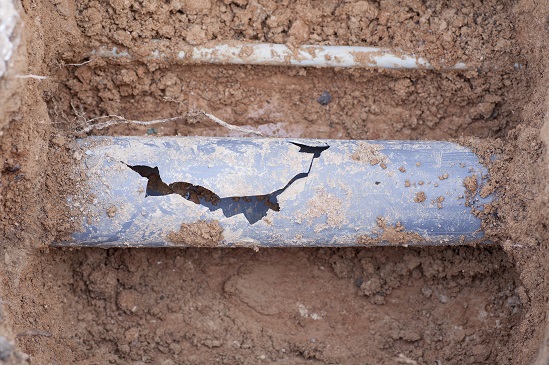
Depending on where you live, Virginia homes use three types of public sewer systems to safely disperse wastewater away from a residence and help protect human and environmental health. Homes in urban and suburban areas or wherever public sewer lines are available connect directly to a county or city-managed utility spur that carries wastewater from the home to the waste treatment plant. Homes in more rural locations without access to city sewage systems utilize a private septic system.
As a water waste management system, your sewer line is at the top of your list of things in your home that you don’t want to fail. Sewer line damage can be unpleasant, messy, and expensive, and you may be wondering who's responsible for your sewer line and if your home insurance will cover a problem.
The main types of sewer systems for homes
There are three main types of public sewer systems: sanitary, stormwater, and combined. Sanitary sewer systems handle wastewater, and stormwater sewer systems handle stormwater. Wastewater must be cleaned at wastewater treatment facilities before being released into the environment. Stormwater systems move stormwater directly to nearby bodies of water without treatment. When excessive rain overwhelms the stormwater system, the mixture may overflow into local streams through designated combined sewer outfalls.
 Illustration courtesy of Alexandria, VA City government
Illustration courtesy of Alexandria, VA City government
How sewer systems work
In urban and suburban areas or wherever public sewer lines are deemed available by the jurisdiction, homes connect directly to the utility spur, and gravity carries waster water away from the home. Low-pressure systems are sometimes used in areas where gravity pipes cannot serve and may use grinder pumps to grind the sewage from your home.
The wastewater flows into underground pipes at an elevated level from the private sanitary laterals that connect properties to the sewer. It follows the downward direction of the pipe to its final destination at a water treatment facility.
 Illustration courtesy of Alexandria, VA City government
Illustration courtesy of Alexandria, VA City government
How to avoid a sewer backup
Sewer lines are designed to have enough level differences from beginning to end to keep sewage moving quickly or rely on a pump. However, sometimes material gets caught in the pipe or pump and blocks water flow. A backup occurs when waste or debris has obstructed a home's plumbing system or lateral, resulting in clogged or slow-moving drains or toilets. When a backup occurs on the homeowner's property, the expense and responsibility for cleanup and repair usually lie with the homeowner. Homeowners are also responsible for maintaining the sewer pipeline from their house to the sewer main-usually under the street in front of the home.
Utility crews are responsible for maintaining the storm drain system from the main in the street and to the treatment facility. This includes cleaning so that during periods of heavy rain, the system will transport rainwater to the correct watershed to prevent flooding. A sewer overflow occurs when a city main becomes blocked, and water or waste materials come up through a sink, bathtub drain, or toilet when the home's plumbing system is unused. An overflow can inflict severe damage, including flooding a room or an entire home.

Common damage to homeowner sewer lines can include:
- Cracked or broken component lines caused by construction, normal wear and tear, or tree root intrusion.
- Clogging debris like rags, diapers, baby wipes, cat litter, cigarettes, coffee grounds, "flushable" wipes, feminine hygiene products, excessive hair, and toys from homes. Other pieces pile up once a single piece gets stuck in the system.
- Grease from cooking oils and foods. In the cooler sewer water, grease coagulates and forms large masses that stick to pipe walls, which can easily cause a blockage.
Plant trees away from sewer lines in your yard since tree roots can intrude pipes and cause the system to fail and back up. Using a toilet or kitchen drain for disposal of non-biodegradable products will often result in home or county sanitary sewer system blockages. Only flush human waste and toilet paper.
Does homeowners insurance cover sewer lines?
Standard homeowners insurance typically does not cover home sewer lines unless the damage results from a sudden event by a covered peril such as fire, lightning, or severe weather. You can purchase additional Service Line Coverage on top of your home insurance policy that provides coverage for repairing and replacing sewer lines from damage that is excluded. For example, regularly flushing nonbiodegradable items into your sewer lines will most likely cause a system blockage and is not covered by your home insurance policy.
This endorsement can protect your septic pipes, other water and sewage pipes, power lines, internet cables and natural gas lines.
Service Line Coverage can pay for damage to your sewer line from:
- Pressure from heavy equipment or vehicles
- Freezing temperatures
- Rodents, vermin, or insects
- Tree roots
- Regular wear and tear
- Mechanical or electrical breakdown
- Deterioration, decay, rust, or corrosion
While Service Line Coverage can cover the damage to your sewer lines, it does not include damage to your home’s interior due to sewer backups. You may want to consider purchasing a sewer backup endorsement. Sewer Backup Coverage can cover repair or restoration costs to your home due to backed-up sewage or water from sewer or drain lines or sump pumps. Service Line Coverage and Sewer backup coverage are generally under $100 annual premium each, depending on your liability limits.


